
A well-structured car sale receipt serves as proof of transaction between the buyer and the seller. It’s a legally binding document that clearly outlines the specifics of the sale, ensuring transparency for both parties. A comprehensive receipt protects both the seller and the buyer in case of disputes or for future reference.
The template for a car sale receipt should include key details such as the vehicle’s make, model, year, VIN (Vehicle Identification Number), and odometer reading. Additionally, it should clearly state the agreed-upon sale price, payment method, and the date of the transaction. Including both the buyer’s and seller’s names, addresses, and contact information helps avoid confusion in case any follow-up is needed.
Always make sure to have both parties sign the receipt. This not only solidifies the agreement but also serves as a safeguard for record-keeping purposes. With the proper template in hand, you can ensure that the transaction is conducted smoothly, leaving no room for misunderstandings or future issues.
Here are the corrected lines:
Ensure the “Date of Sale” field is clearly marked, as it’s crucial for both parties to reference later. The buyer’s full name, along with the address, should follow in separate fields for clarity and legal accuracy.
Adjust the “Vehicle Identification Number” (VIN) format to match the standard for easy validation. This helps prevent errors and ensures consistency across records.
The “Amount Paid” section needs to list the total sale amount, including taxes or fees, with a clear breakdown if applicable. This prevents confusion and ensures transparency in the transaction.
Lastly, update the “Seller’s Information” to include contact details, making it easy for the buyer to reach out with questions after the sale.
- Template for Car Sale Receipt
A car sale receipt template should include key details to confirm the transaction between the buyer and seller. Ensure that all necessary information is accurately listed to avoid future disputes. Below is a simple and clear format to follow when creating a receipt for a car sale.
| Field | Description |
|---|---|
| Receipt Number | Assign a unique number for tracking purposes. |
| Date of Sale | Indicate the exact date when the transaction took place. |
| Seller’s Information | Include the full name, address, and contact details of the seller. |
| Buyer’s Information | Include the full name, address, and contact details of the buyer. |
| Vehicle Information | List the make, model, year, VIN (Vehicle Identification Number), color, and mileage. |
| Sale Price | Clearly state the agreed sale price of the car. |
| Payment Method | Specify how the payment was made (e.g., cash, bank transfer, etc.). |
| Odometer Reading | Record the mileage of the vehicle at the time of sale. |
| As-Is Clause | If applicable, include a statement that the car is sold “as-is” without warranties. |
| Signatures | Both the buyer and seller should sign the receipt to confirm the sale. |
Ensure that all fields are filled correctly. This will make the sale process smoother and provide clear documentation for both parties. Keep a copy of the receipt for your records.
Make sure to clearly list both parties’ full names, addresses, and contact information. This ensures that the transaction is properly recorded and both the buyer and seller can be reached if needed.
Seller Details
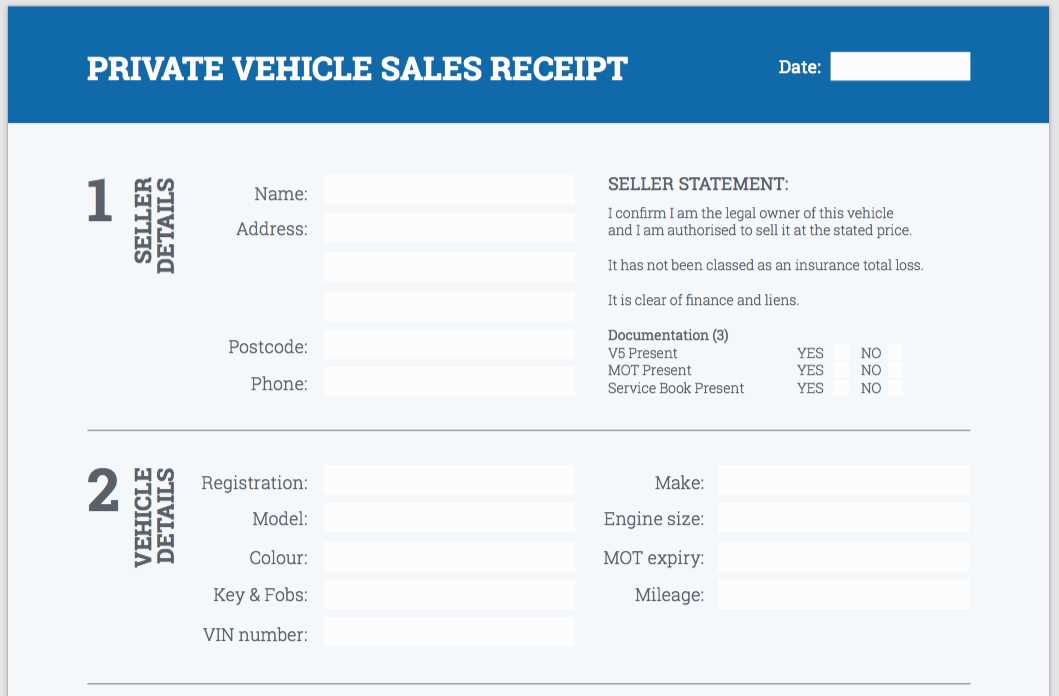
- Name: Include the seller’s full legal name.
- Address: Provide the complete address, including street, city, and postal code.
- Phone Number: Include a current contact number for easy communication.
- Email Address: Optional, but useful for follow-up or digital correspondence.
Buyer Details
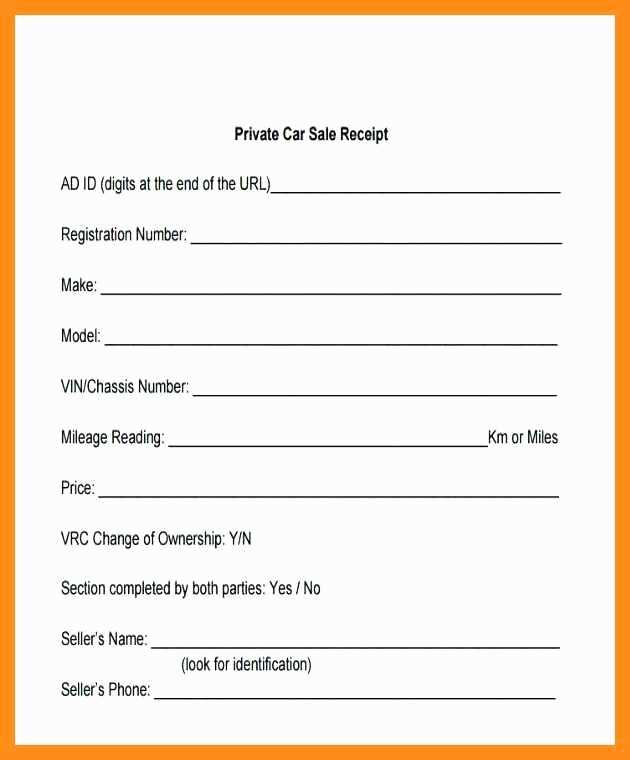
- Name: List the full name of the buyer as shown on their identification documents.
- Address: Include the buyer’s current address, including street, city, and postal code.
- Phone Number: Add a contact number for the buyer.
- Email Address: Include this if applicable, especially for digital records or notifications.
Accurate details prevent any disputes later on and help confirm the identity of both parties involved in the transaction.
Make sure to include the Vehicle Identification Number (VIN) on the receipt. This unique code serves as the fingerprint of the vehicle, confirming its identity. Double-check the VIN for accuracy, as it must match the one on the vehicle and any registration documents.
Alongside the VIN, list the vehicle’s make, model, year, and color. This helps in further verifying the vehicle’s details and ensures transparency for both the buyer and seller. For additional clarity, include the odometer reading at the time of sale to reflect the vehicle’s mileage.
It’s also a good idea to include the license plate number. This ties the vehicle directly to its current registration and can assist with future transactions or inquiries.
Ensure the receipt includes the seller’s and buyer’s information, such as names and contact details, to avoid confusion in case of disputes or follow-up communication regarding the vehicle.
When recording a car sale, specifying the payment method on the receipt is crucial. This helps clarify how the buyer paid for the vehicle, ensuring transparency and eliminating any confusion later on.
Cash payments are straightforward. The receipt should clearly indicate the amount paid in cash, along with the corresponding date. If there’s any change, it should also be reflected on the document.
Credit or Debit Card payments require additional details like the last four digits of the card number (if applicable), the transaction ID, and the payment processor used. This ensures both the buyer and seller can confirm the payment method and amount, should any disputes arise.
Bank Transfers are another common method. The receipt should include the transfer reference number and the bank’s name to verify that the funds were successfully transferred. A timestamp of the transaction is also necessary for accuracy.
Installment Payments are often part of a car sale agreement. The receipt should break down the total price, the deposit received, and any scheduled payments. For clarity, include the balance due and the due dates for the next payments.
Trade-in Vehicles as part of the payment also need to be documented. The value of the trade-in should be listed, and if it’s subtracted from the overall sale price, both values should be clearly marked.
Each payment method serves a different function, and listing them properly ensures that both the buyer and seller have a clear understanding of the transaction. This avoids misunderstandings and provides proof of payment in any potential disputes.
Clearly list the taxes and fees on the car sale receipt to ensure transparency. Include the sales tax rate applied to the sale price, calculated based on local regulations. For example, if the car is sold for $20,000 and the applicable sales tax rate is 8%, the receipt should reflect a tax amount of $1,600.
Any additional fees should also be itemized. Common fees include documentation fees, title and registration fees, and licensing charges. If the buyer opts for a warranty, include the warranty cost separately. For financing, clearly show any interest or fees associated with the loan.
If applicable, make sure to specify any trade-in credits or rebates the buyer is receiving. For example, if the customer traded in a vehicle worth $5,000, deduct that amount from the total sale price before calculating the tax.
Lastly, include any applicable government fees, such as emission testing fees or other state-specific charges. This ensures all taxes and fees are accounted for, providing clarity for both the seller and the buyer.
When drafting a car sale receipt, clearly specify the warranty or “as-is” condition to avoid misunderstandings. If the car is sold with a warranty, outline the duration, coverage, and any conditions. For an “as-is” sale, ensure the receipt states that the buyer accepts the vehicle without any guarantees regarding its condition. This protects both the seller and the buyer in case of issues after the transaction.
1. Warranty Details
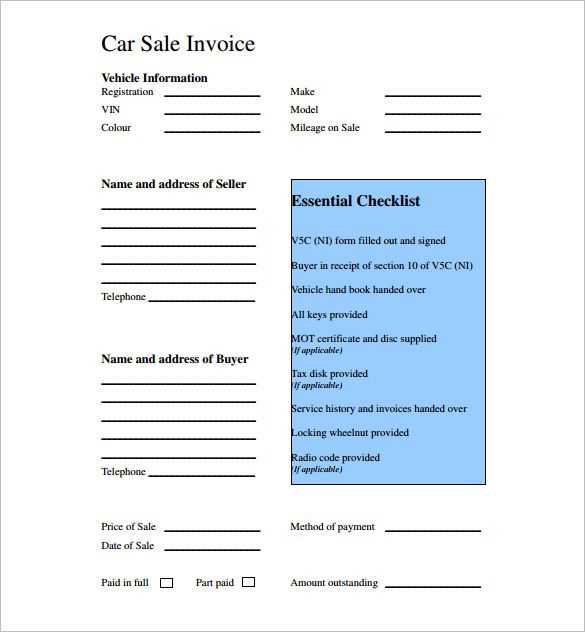
If the car is sold with a warranty, include the following specifics:
| Warranty Type | Description |
|---|---|
| Duration | State the length of the warranty (e.g., 6 months, 1 year). |
| Coverage | Detail what parts or services are covered under the warranty (e.g., engine, transmission). |
| Exclusions | List any exclusions from the warranty (e.g., wear and tear, cosmetic damage). |
2. “As-Is” Condition
If the car is sold “as-is,” include a clear statement such as: “The vehicle is sold in its current condition without any warranty, either express or implied.” This statement ensures that the buyer understands they are purchasing the vehicle without recourse for future claims about its condition.
Additionally, note any known issues or past repairs in the receipt to provide full transparency. This helps protect the seller from potential legal claims related to the car’s condition post-sale.
Always include a section for signatures on the car sale receipt to ensure legal validity. Both the buyer and seller must sign the document to confirm the terms of the transaction. Signatures act as a form of agreement and help avoid disputes later on. If possible, use two separate signature lines: one for the buyer and one for the seller. This shows mutual consent to the terms outlined in the receipt.
Physical Signatures
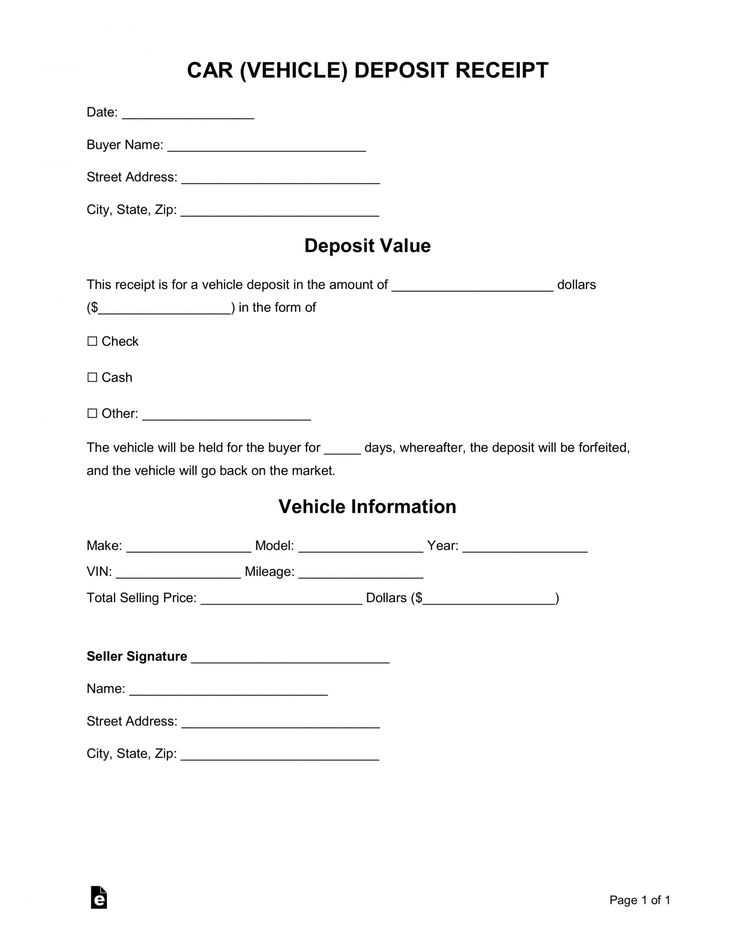
For physical transactions, the signatures of both parties are mandatory. Ensure that both individuals are present when the document is signed. The receipt should include the date and place of signing, providing clarity on the time and location of the agreement. This helps establish the legal timeline of the sale.
Digital Signatures
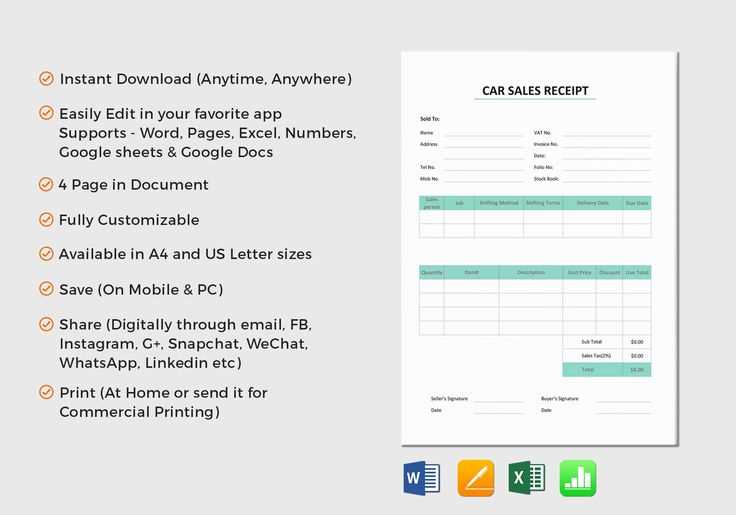
If the transaction is conducted online, consider using digital signatures to confirm the agreement. Digital signatures are legally recognized in most jurisdictions and carry the same weight as physical signatures. Make sure the platform you use is secure and compliant with local e-signature laws to maintain the validity of the receipt.
Lastly, keep a copy of the signed receipt for both parties. This will serve as proof in case any legal issues arise regarding the sale of the car.
To ensure clarity in your car sale receipt, include these key details:
- Buyer Information: Clearly list the buyer’s full name, address, and contact number.
- Seller Information: Include the seller’s full name and contact information.
- Car Details: Record the make, model, year, VIN (Vehicle Identification Number), and odometer reading at the time of sale.
- Payment Details: Specify the total sale amount, payment method (cash, check, or financing), and the date of transaction.
- Terms of Sale: Outline any conditions such as warranties, “as-is” clauses, or repair agreements.
- Signature Section: Provide spaces for both parties to sign and date, confirming the transaction.
These points guarantee that both parties have clear documentation for the sale. Keeping the receipt straightforward and organized will avoid any misunderstandings down the line.


